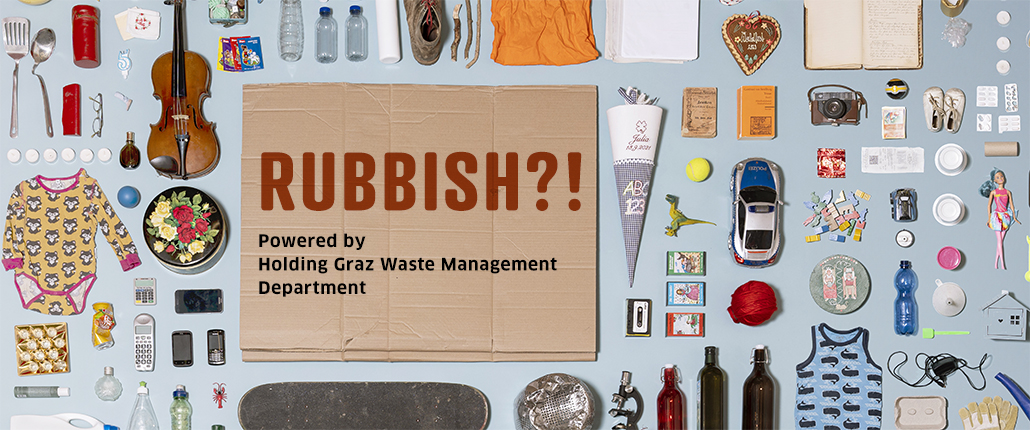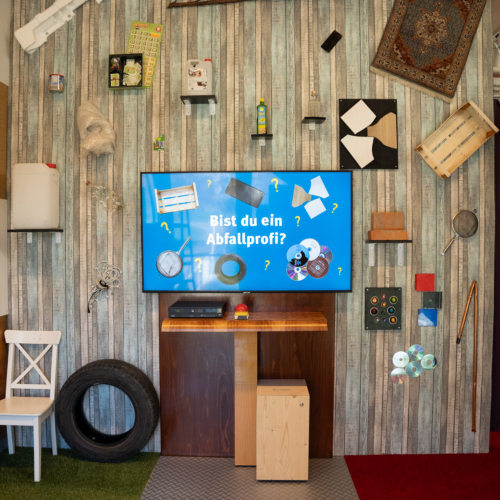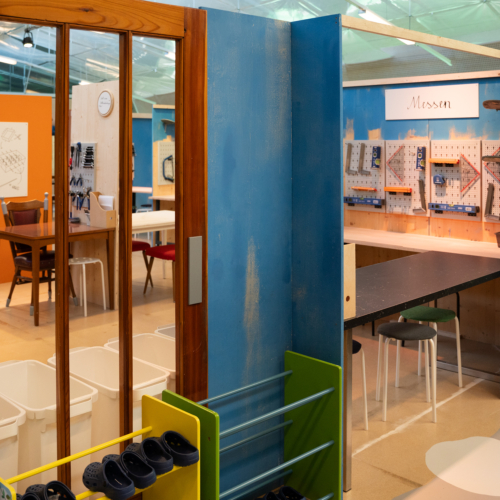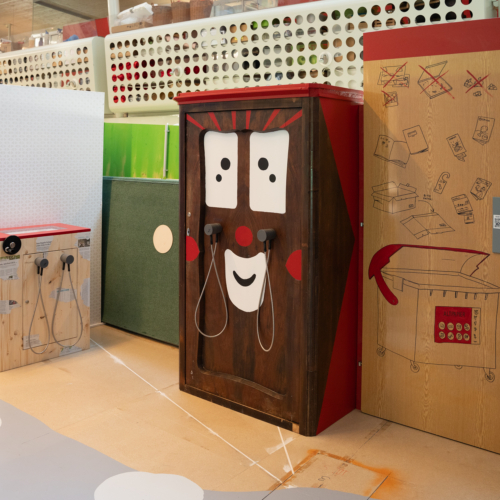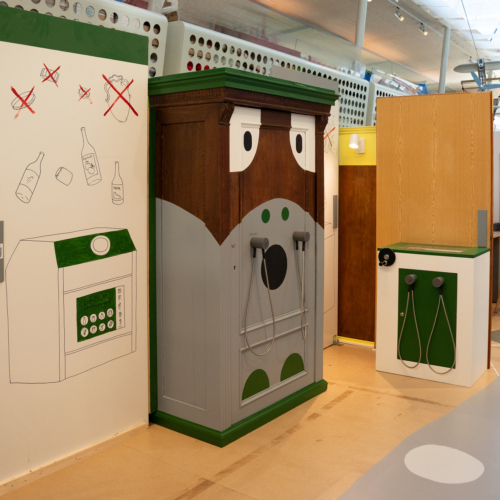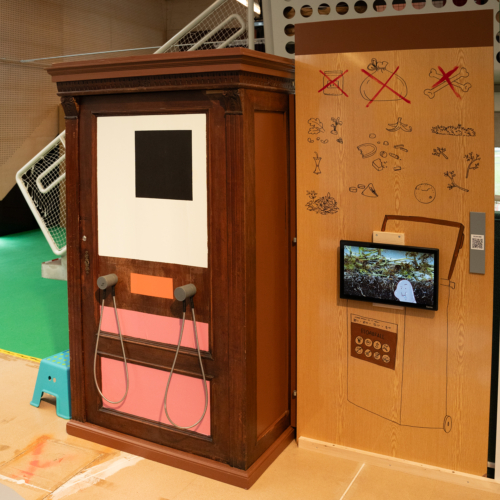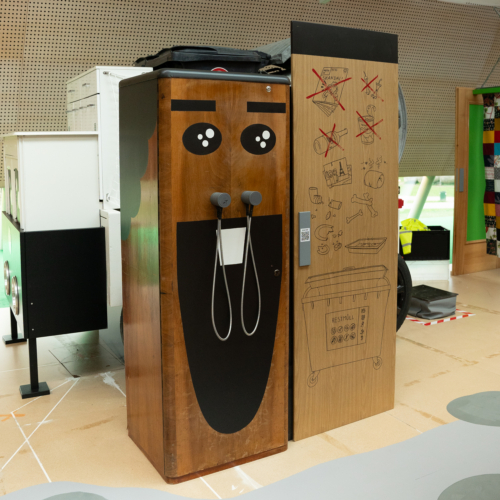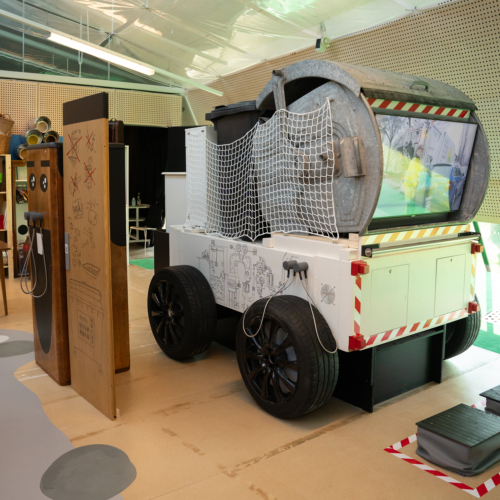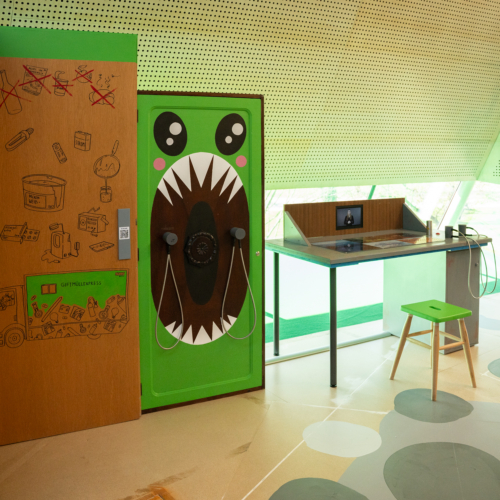How is this waste disposed of?
Broken tile
Where is the right place for a broken tile? In the “bulky waste” bin? Then stand on the rough surface on the left. Or does it belong in the “ceramics” collection bin? Then stand on the smooth surface in the centre. Or to “grey construction waste”? Then stand on the soft surface on the right. Yes, tiles belong in the “ceramics” collection bin! If you were right, you can now take a sash!
Broken CD
Where is the right place for a broken CD? In the “CD jewel cases” collection bin? Then stand on the rough surface on the left. Or does it belong in the “CDs, DVDs, Blu-Rays” collection bin? Then stand on the smooth surface in the centre. Or does it belong in the “plastic hollow bodies / canisters smaller than 5 litres” bin? Then stand on the soft surface on the right. Yes, CDs belong in the “CDs, DVDs, Blu-Rays” collection bin! If you were right, you can now take a sash!
CD jewel case
Where is the right place for the CD jewel case? In the “CD jewel cases” collection bin? Then stand on the rough surface on the left. Or does it belong in the “CDs, DVDs, Blu-Rays” collection bin? Then stand on the smooth surface in the centre. Or does it belong in the “plastic hollow bodies / canisters smaller than 5 litres” bin? Then stand on the soft surface on the right. Yes, of course, the CD jewel case belongs in the “CD jewel cases” collection bin! If you were right, you can now take a sash!
Damaged carped
Where is the right place for the damaged carpet? In the “bulky waste” collection bin? Then stand on the rough surface on the left. Or does it belong in the “red construction waste” collection bin? Then stand on the smooth surface in the centre. Or in the “carpets” collection bin? Then stand on the soft surface on the right. Yes, of course, the old carpet belongs in the “carpets” collection bin! If you were right, you can now take a sash!
Coffee capsule
Where is the right place for this coffee capsule? In the “metal packaging” collection bin? Then stand on the rough surface on the left. Or does it belong in the “Nespresso capsules” collection bin? Then stand on the smooth surface in the centre. Or does it belong in the “plastic packaging film” bin? Then stand on the soft surface on the right. Yes, of course, the coffee capsule belongs in the “Nespresso capsules” collection bin! If you were right, you can now take a sash!
Crate
Where is the right place for this crate? In the “wood packaging” collection bin? Then stand on the rough surface on the left. Or does it belong in the “tree and shrub cuttings” collection bin? Then stand on the smooth surface in the centre. Or in the “waste wood for thermal recycling” bin? Then stand on the soft surface on the right. Yes, the crate belongs in the “wood packaging” collection bin! If you were right, you can now take a sash!
Polystyrene packaging
Where is the right place for this polystyrene packaging? In the “plastic packaging” collection bin? Then stand on the rough surface on the left. Or does it belong in the “polystyrene packaging” collection bin? Then stand on the smooth surface in the centre. Or in the “PVC waste” bin? Then stand on the soft surface on the right. Yes, the polystyrene packaging belongs in the “polystyrene packaging” collection bin! If you were right, you can now take a sash!
Plastic hollow body
Where is the right place for this plastic hollow body? In the “plastic packaging” collection bin? Then stand on the rough surface on the left. Or does it belong in the “plastic hollow bodies smaller than 5 litres” collection bin? Then stand on the smooth surface in the centre. Or does it belong in the “plastic hollow bodies larger than 5 litres” bin? Then stand on the soft surface on the right. Yes, this plastic hollow body belongs in the collection bin “hollow plastic bodies smaller than 5 litres”! If you were right, you can now take a sash!
Plastic hollow body
Where is the right place for this plastic hollow body? In the “plastic packaging” collection bin? Then stand on the rough surface on the left. Or does it belong in the “plastic hollow bodies smaller than 5 litres” collection bin? Then stand on the smooth surface in the centre. Or does in belong in the “plastic hollow bodies larger than 5 litres” collection bin? Then stand on the soft surface on the right. Yes, this plastic hollow body belongs in the “plastic hollow bodies larger than 5 litres” collection bin! If you were right, you can now take a sash!
Game
What is the right place for this game? The “re-use zone”? Then stand on the rough surface on the left. Or does it belong in the “waste paper” collection bin? Then stand on the smooth surface in the centre. Or in the “cardboard packaging” bin? Then stand on the soft surface on the right. Yes, this game is still perfectly fine. It would be a shame to throw it away. It belongs in the “re-use zone”. That way it can still be used. If you were right, you can now take a sash!
Packaging film
Where is the right place for this packaging film? In the “plastic packaging film” collection bin? Then stand on the rough surface on the left. Or does it belong in the “plastic packaging” collection bin? Then stand on the smooth surface in the centre. Or does it belong in the “polystyrene packaging” bin? Then stand on the soft surface on the right. Yes, this packaging film belongs in the “plastic packaging film” collection bin! If you were right, you can now take a sash!
Pipe
Where is the right place for this pipe? In the “construction waste” collection bin? Then stand on the rough surface on the left. Or does it belong in the “bulky waste” collection bin? Then stand on the smooth surface in the centre. Or in the “copper” collection bin? Then stand on the soft surface on the right. Yes, this pipe belongs in the “copper” collection bin! If you were right, you can now take a sash!
Can
Where is the right place for this can? In the “Nirosta (stainless steel)” collection bin? Then stand on the rough surface on the left. Or does it belong in the “metal packaging” collection bin? Then stand on the smooth surface in the centre. Or in the “mixed scrap iron” bin? Then stand on the soft surface on the right. Yes, this tin belongs in the “metal packaging” collection bin! If you were right, you can now take a sash!
Glass
Where is the right place for this glass? In the “clear glass packaging” collection bin? Then stand on the rough surface on the left. Or does it belong in the “coloured glass packaging” collection bin? Then stand on the smooth surface in the centre. Or in the “flat glass” bin? Then stand on the soft surface on the right. Yes, this glass belongs in the “coloured glass packaging” collection bin! If you were right, you can now take a sash!
Glass
Where is the right place for this glass? In the “clear glass packaging” collection bin? Then stand on the rough surface on the left. Or does it belong in the “coloured glass packaging” collection bin? Then stand on the smooth surface in the centre. Or in the “flat glass” bin? Then stand on the soft surface on the right. Yes, this glass belongs in the “clear glass packaging” collection bin! If you were right, you can now take a sash!
Sieve
Where is the right place for this sieve? In the “Nirosta (stainless steel)” collection bin? Then stand on the rough surface on the left. Or does it belong in the “metal packaging” collection bin? Then stand on the smooth surface in the centre. Or in the “mixed scrap iron” bin? Then stand on the soft surface on the right. Yes, this sieve belongs in the “mixed scrap iron” collection bin! If you were right, you can now take a sash!
Brick
Where is the right place for this brick? In the “red construction waste” collection bin? Then stand on the rough surface on the left. Or does it belong in the “construction residues” collection bin? Then stand on the smooth surface in the centre. Or in the “grey construction waste” bin? Then stand on the soft surface on the right. Yes, this brick belongs in the “red construction waste” collection bin! If you were right, you can now take a sash!
Cable
Where is the right place for this cable? In the “small electrical appliances” collection bin? Then stand on the rough surface on the left. Or does it belong in the “appliance batteries” collection bin? Then stand on the smooth surface in the centre. Or in the “cables” collection bin? Then stand on the soft surface on the right. Yes, this cable belongs in the “cables” collection bin! If you were right, you can now take a sash!
Battery
Where is the right place for this battery? In the “small electrical appliances” collection bin? Then stand on the rough surface on the left. Or does it belong in the “appliance batteries” collection bin? Then stand on the smooth surface in the centre. Or in the “lithium batteries” bin? Then stand on the soft surface on the right. Yes, this battery belongs in the “appliance batteries” collection bin! If you were right, you can now take a sash!
Broken mobile phone
Where is the right place for this broken mobile phone? In the “small electrical appliances” collection bin? Then stand on the rough surface on the left. Or does it belong in the “display devices” collection bin? Then stand on the smooth surface in the centre. Or does it belong in the “large electrical appliances” collection bin? Then stand on the soft surface on the right. Yes, this mobile phone belongs in the “small electrical appliances” collection bin! If you were right, you can now take a sash!
Broken CD player
Where is the right place for this broken CD player? In the “small electrical appliances” collection bin? Then stand on the rough surface on the left. Or does it belong in the “display devices” collection bin? Then stand on the smooth surface in the centre. Or does it belong in the “large electrical appliances” bin? Then stand on the soft surface on the right. Yes, this CD player belongs in the “small electrical appliances” collection bin! If you were right, you can now take a sash!
Broken car tyre
Where is the right place for this broken car tyre? In the “tyres with rims” collection bin? Then stand on the rough surface on the left. Or does it belong in the “bulky waste” collection bin? Then stand on the smooth surface in the centre. Or in the “tyres without rims” collection bin? Then stand on the soft surface on the right. Yes, this tyre belongs in the “tyres without rims” collection bin! If you were right, you can now take a sash!
Broken chair
Where is the right place for this broken chair? In the “waste wood for thermal recycling” collection bin? Then stand on the rough surface on the left. Or does it belong in the “waste wood for material recycling” collection bin? Then stand on the smooth surface in the centre. Or in the “wood packaging” bin? Then stand on the soft surface on the right. Yes, this chair belongs in the “waste wood for material recycling” collection bin! If you were right, you can now take a sash!
Branches
Where is the right place for these branches? In the “waste wood for thermal recycling” collection bin? Then stand on the rough surface on the left. Or do they belong in the “waste wood for material recycling” collection bin? Then stand on the smooth surface in the centre. Or in the “tree and shrub cuttings” collection bin? Then stand on the soft surface on the right. Yes, these branches belong in the “tree and shrub cuttings” collection bin! If you were right, you can now take a sash!

